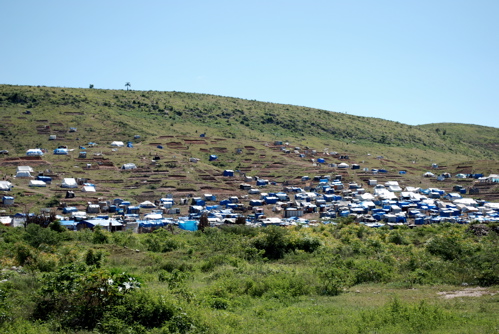 Camp Canaan
Camp Canaan
While in Haiti, we notified a health monitoring service about suspected outbreaks of up to 100 cases of diptheria in Camp Cannan, twelve miles north of Port-au-Prince. Camp leaders gave us the figure. Based on the WHO public announcement to the media on May 11 that there "was no evidence of epidemic diphtheria", monitors reasonably believed our report to not be plausible. Even now, there has been no official announcement to many of the NGOs of the outbreak, highlighting challenges in communication with public health. Someone should listen to the Haitian people.
On Tuesday, May 18 the United Nations announced agencies are helping health authorities in Haiti carry out an emergency vaccination campaign after an outbreak of diphtheria in the capital, Port-au-Prince. Cases of the disease were first reported on Saturday, May 15 in Camp Batimat in Cité Soleil district, one of the settlements housing people displaced by the January earthquake, Christiane Berthiaume, spokesperson for the UN Children's Fund (UNICEF), told reporters in Geneva
Camp Cannan is located near Cité Soleil and is a source of what little food residents can obtain.
About 2,000 people possibly exposed to the diphtheria bacterium are being specifically targeted in the vaccination campaign, carried out by more than 80 vaccinators, the UN said.
With up to 8,000 people exposed in Camp Cannan, we can suggest the numbers may be much higher.
Diphtheria is an infectious disease that spreads from person to person through respiratory droplets from the throat through coughing and sneezing. The illness usually affects the tonsils, pharynx, larynx and occasionally the skin. Symptoms range from a moderately sore throat to toxic life-threatening diphtheria of the larynx or of the lower and upper respiratory tracts.
Here is our report on the lost voices of Camp Canaan and the Potemkin Village that is Camp Corail. It is urgent that they be heard.
Much of this was published in the LA Progressive and OEN, but it desperately needs to be restated, especially in the wake of the diptheria outbreak.
-----
The sign on the dusty plain adjacent to Highway One twelve miles north of Port-au-Prince read, "We Need Help." That was in March; on May 11 the sign was still there, and USAID was reporting that $1,059,050,150 had gone to Haiti since January 2010 through "implementing partners." The people in what we had dubbed the "camp with no name" were still there, too, and the only noticeable difference was that the Irish NGO HAVEN had made good on its promise to install latrines. However one look into the latrines and it was obvious that diarrheal disease was on the rise.
At least the rubber bladder was getting two deliveries of chlorinated water per day now. In a desperate bid for attention, camp leaders had briefly named the IDP settlement "Camp Obama," but had been pressured by "someone" to change the name to "Camp Canaan."
This stretch of arid land is like a desert in the dry season and scattered clumps of cactus are silent sentinels to conditions here. In March, the winds blew so much dirt that we were constantly wiping camera lenses, and our faces and arms were caked with a sticky dust that blackened towels and hand wipes.

But, like the deserts of Arizona, this plain is subject to flooding when the spring rains come and water pours down the ravines of the suitably named Mon Cabrit, or Goat Mountain. We say, "suitably named" because the American taxpayer may end up being the goat in this saga.
In an unbelievable lack of planning and haphazard distribution of "aid," a Potemkin Village of white tents courtesy of USAID's implementing partners, World Vision and OXFAM, now adjoins Camp Canaan. Look beneath the surface of this flagship Haitian government project and one realizes that the residents of "Camp Corail" are really no better off than the residents of Camp Canaan, except for the fact that their tents do not leak--so far. We spent the better part of day examining life in the two camps and it is not a pretty picture; no matter how white the tents in the new settlement, no matter how orderly the rows, or how level the gravel remains--courtesy of UN graders.
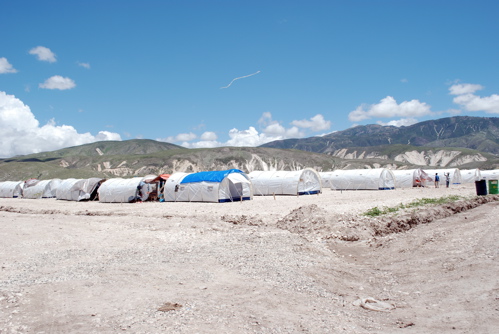
We were eager to revisit Camp Canaan to see how they fared since our March visit, so it was the first stop after landing via American Airlines in Port-au-Prince. Colleague Mac McKinney from OEN news was along on this trip, and it was really good to have another set of eyes.
It took nearly and hour to go twelve miles because of a combination of abominable roads and traffic snarls that have to be experienced to be appreciated. Imagine life for camp residents here-- no transportation and no shade from a relentless tropical sun that beats down mercilessly. The displaced Haitians here experience blistering heat in day, and then temperatures drop precipitously at night as the rains come and flood the tattered tents at the base of Goat Mountain.
Camp leaders, led by the familiar face of Joseph Michel, greeted us happily saying that we were the only journalists to return to check on them. There is no way to know if this is true, but they were clearly relieved to see us and update their story.
The women were also eager to reintroduce us to babies we had met on our last visit, but none were thriving. Orange hair on babies is an obvious sign of malnutrition, and an especially frustrating red flag when USAID reports that the World Food Program has been given $69,815,600 to purchase 55,280 metric tons of Emergency Food Assistance since January. There are over 2 million displaced persons in Haiti now. Do the math. At a little over $34 per person, it won't and did not go far. Camp residents report that they pool about ten cents a day per family member (approximately 3,000 families) to purchase food that provides them one meal a day. Camp Canaan receives no "free" food deliveries.
One of our first tasks was to send a photo via our Blackberry of the genitals and bottom of an infant to a family practice doctor in Minnesota. We won't show it here for obvious reasons, but the skin was a blistered, hardened mass of flesh. The doctor got back to us within twenty minutes and said that the problem was chronic severe dermatitis complicated by a secondary yeast infection, and that "malnutrition worsens the problem." Here is Mom and Baby:
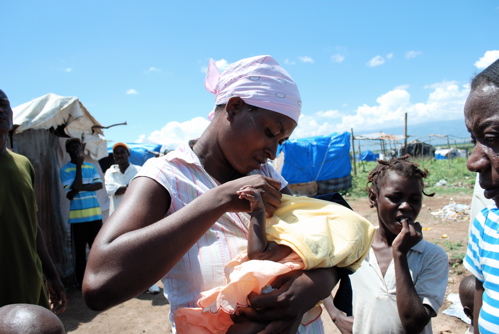
The nearest health clinic was in Cite Soleil and the infant needed to get there. But how does a mother with no money and no transportation "get" anywhere. Our Haitian translator, Andre Paultre, immediately gave the women money for transport via "tap tap" (taxi) for a clinic visit. The tap-tap cost 50 Gourdes or about $1.10 US.
Consider that USAID lists "logistics" aid of $460 million, but there is no transportation to and from these rural camps. One regular bus run would be a godsend.
Cite Soleil is 20 minutes away.
Regarding the orange hair--orange hair is just wrong. You feel it when you see it. It is an innate response of revulsion that psychologists have told me is the result of a primal mammalian instinct. Not maternal, but mammalian. I want to be clear. Genetics long ago programmed survival and recognition of disease and impending death into our species. The "normal" reaction is to flee, but mores, thankfully, prevents this. Even if the babies did not have orange hair, one would know something is terribly wrong by the hollowed, glassy expressions in their eyes.
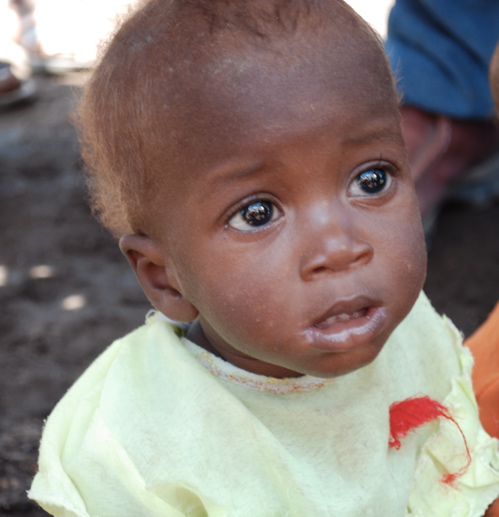
If malnutrition is not enough to kill babies, flooding tents, dirt floors and little to no bedding aids and abets the stalking Grim Reaper. Moms report increasing fevers and coughing, eagerly positioning a pair of obviously sick twins on a piece of cardboard for us. It was their idea. Why? They wanted us to take a photo and get it back to America. Take a look and see what you will.
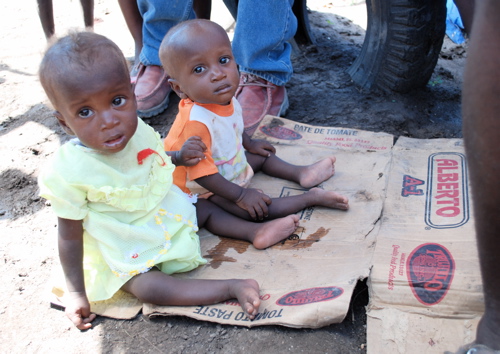
What is unconscionable is that most of the tents are still tattered and have no prayer of keeping out the rain. Light gauge blue tarps made in China have shredded to lace. There are sturdier tarps that have been donated through USAID and other charitable organizations, but the only way for residents of Camp Canaan to procure these tarps is to go to the black market and purchase them.
Here is one example.
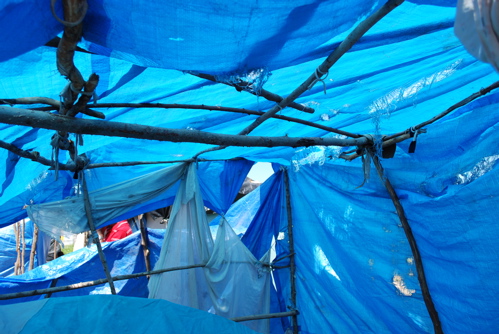
In January, shortly after the earthquake, the US Navy reported, members from the Buddhist Tzu Chi Foundation donated 2000 tarps and blankets.
So we went to the nearest market and it took us minutes to locate the donated Buddhist tarps that now had price tags of 500 Gourdes or about $12 US. The vendors were eager to unfurl the quality tarps but would not offer up how they came by them. Two stalls down we spied some USAID tarps, but every time we tried to take a photo the vendor angrily turned them over so the logo was not visible. We did not want to press our luck.
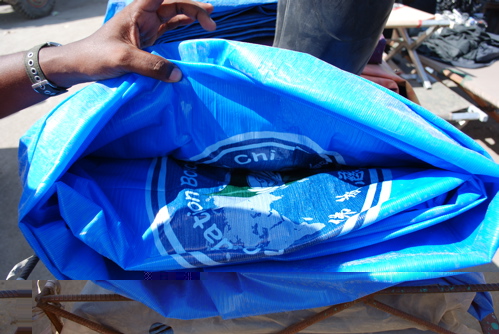
As serendipity would have it, Al Jazeera must have been on the trail of the pilfered tarps at the same time we were, because this video surfaced in the last day and corroborates what we found, and more.
The USAID tarps were a bargain at $7.50 and of similar quality as the Buddhist tents. We found one of the USAID tarps covering a Volkswagon on the side streets of Port-au-Prince.
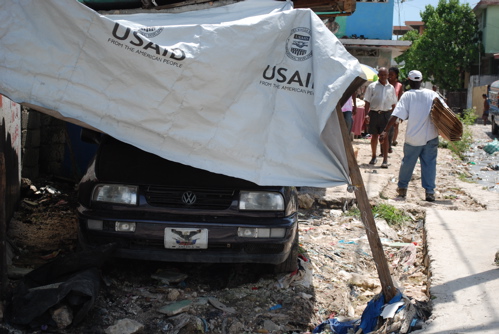
The bigger question still haunts us. Why is it acceptable for Haitians to live in tents, tattered or not? World Vision has received at least $19 million for housing.
Having seen more than enough, we moved up the road about two minutes by car to Camp Corail. Remember the story of Grigori Aleksandrovich Potemkin, commander-in-chief of the Russian army in the late eighteenth century, who was also the lover of Catherine the Great? Potemkin had elaborate fake villages constructed for Catherine's tours of the Ukraine and the Crimea. "Aid" has now created a similar city of illusion within sight of the shredded blue tarps of Camp Canaan. It is only the color of the tents and the strength of the plastic and nylon tents that delineates the two camps.
America's sudden love affair with Haiti has helped to create this city of illusion within sight of the "tents" of Camp Canaan --and all anyone wants is to "go home."
USAID, the International Office of Migration (IOM), Catholic Relief Services (CRS), the US Army's 82nd Airborne division, the Haitian government, OXFAM, and World Vision erected approximately 1300 bright white tents that shimmer on the hot barren plain just a stone's throw from forgotten Camp Canaan. The gravel that serves as the "foundation" for the tents is as white as the tents, and the whole effect is like that of a gleaming desert. The American flag adds a surreal touch.

USAID figures report that 4,921 people have been moved to Camp Corail from Petionville. Talk to the people here and all they want is to get out from underneath the sweltering nylon that makes it impossible to stay inside the tents from noon until 3 pm. They may have escaped the mud, but now they are hungry and their tents are still flooding. To compound matters, they are absolutely as isolated as their hapless neighbors in Camp Canaan on a desert-like plain that floods at night.
Residents report that they were promised a three-month supply of food. One month after relocation, they say they are out ov food and the small amounts of rice they have cannot be cooked because there is no charcoal to do so. We were lucky to get the interviews because the UN usually keeps visitors at bay. After Save the Children spotted us, a UN patrol appeared, but by that time we were well on our way out of the camp.
USAID reports that the WFP maintains 35,000 metric tons (MT) of mixed food commodities in stock in Haiti. Why warehouse it if these two camps and several more we visited are going hungry?
A woman showed us her remaining ration of food--an "A-Pack emergency meal" of 1310 calories. We looked up the standard emergency pack and it should be anywhere from 2100-3600 calories.

These people are getting less than one meal per day, and 1300 calories at most. The pack consists of spaghetti, an oatmeal cookie, a strawberry toaster pastry, peanut butter, raisins, a cracker, a non-descript "raspberry beverage," a spoon, and "towelette." The Ameriqual Group of Evansville, Indiana produces these meals.
Ameriqual Group, LLC, d/b/a Ameriqual Packaging, Evansville, Ind. is being awarded a maximum $37,520,000 fixed-price with economic price adjustment, indefinite-quantity contract for Meal, Ready-to-Eat (MRE). There are no other locations of performance.
Using services are Army, Navy, Air Force, Marine Corps and federal civilian agencies. There were originally three proposals solicited with three responses. Contract funds will expire at the end of the current fiscal year. The date of performance completion is Dec. 31, 2010. The Defense Supply Center Philadelphia (DSCP), Philadelphia, Pa., is the contracting activity (SPM3S1-06-D-Z103).
Go to the company's ordering website and there is a notice posted there that due to demand in Haiti, they are out of meals, but you can "pre-order."
Since the food is gone, angry residents told us they were hopeful about another program that was due to start the same day we were there, but had not. Cash for Work and Food would provide $5 per day for labor, $2.50 worth of food and $2.50 in cash, but there is no way to get anywhere to spend the cash and there are no food deliveries anymore.
As the crowd grew larger around our battered blue Mitsubishi, here are some of the things we heard about the Haitian government's premier facility for IDPs.
"We don't know what will happen."
"We need food, people are waiting for work."
"There is not enough light at night."
"There are stones under the tents, no mattresses, and we cannot sleep."
"I have back pain because of the stones."
"The stones put holes in the tent floors and water gets in and pushes up the tent."
"The tents shake in the wind and the stakes pull out of the ground."
"Last night we had a 6.7 wind."
These tents are supposed to be hurricane proof and the resident was using the metaphor of an earthquake to demonstrate how vulnerable residents felt in a thunderstorm.
"We pass out in the heat."
"They just forced us to move from Petionville camp."
"When our President Preval came to visit with VIPS he looked so weak he needed help to walk."
Haiti needs real help to walk and stand on its own two feet. These people are ready and willing to work, but are still caught in the stranglehold of "aid." IDP camps are turning into virtual prisons. Someone needs to figure out where the money is going before there is a total societal breakdown here. What has become "normal" in Haiti is a cancer on the face of civilization.
How the World Health Organization can downplay news of a deadly diptheria outbreak in the Haiti IDP camps and not have it make headlines is beyond the pale.
